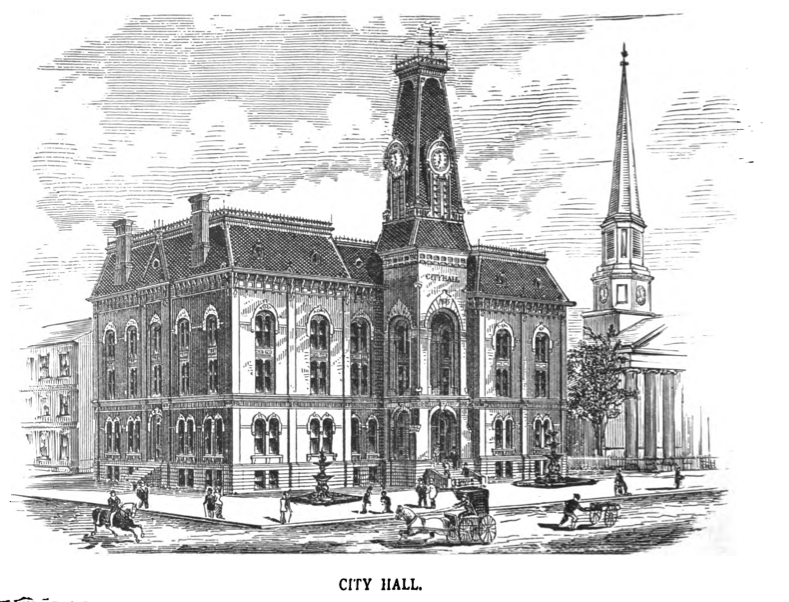
Troy seems to be an anomaly these days, a city without a permanent city hall. For years it was in an atrocious ’70s style concrete abomination, now torn down to make way for riverfront redevelopment. For now it’s in a different atrocious ’70s style concrete abomination, with plans to move it back to Monument Square. There has been much squabbling in the interim. Squabbling about City Hall seems to be a long-standing Troy tradition.
This beautiful structure was once Troy’s City Hall, at the southeast corner of Third and State. It was also the product of much squabbling. The first city hall, authorized in 1869, was to have been a joint venture with the Troy Savings Bank, which would have owned the building jointly with The City-Hall Company of the City of Troy. That project was abandoned when the Savings Bank decided to build a banking house on the northeast corner of Second and State Streets. It’s still there today, of course.
Mayor Edward Murphy, Jr., in his first message to the common council in 1875, said “If there is any public building our citizens need, it is a city-hall.” There was then a movement afoot to purchase the Athenaeum Building for the purpose, which Mayor Murphy opposed. He preferred the site of a former burial ground at Third and State then held by the Vanderheyden family. “the land was originally donated to the city for a burial-ground, but as it is now no longer used for that purpose, it seems to me to be a most eligible location for the erection of a suitable public building to be known as a city-hall.” The common council went the other way, ordering a special committee to buy the Athenaeum Building on First Street, in which the city already had offices. The mayor vetoed the $60,000 purchase. The council seems to have acquiesced, for shortly after, on May 21, 1875, an act was passed authorizing $120,000 for a new city hall. The Third Street Burial Ground was selected in June, and architectural plans adopted in July. The remains of 208 persons were removed to Oakwood and other cemeteries at the expense of the city during the summer, and the cornerstone was laid on November 15, 1875. The building was completed and occupied in October, 1876.
Arthur Weise relates the details:
“The edifice is 150 feet long and 83 wide, built of Philadelphia pressed brick, with sand-stone and iron trimmings. The common council chamber, on the second story and north end of the building, is 60 feet long and 40 wide. The public hall, on the same story, at the south end of the building, has a gallery, and will contain 1,100 people. The total cost of the city hall, including its site and furniture, was $119,761.61. The clock was placed in the tower, August 1885.” The clock represented an additional expense of $1,300. Made by the Howard Watch and Clock Company of New York, it began running August 21, 1885. “The east and west dials are 8 feet in diameter; the north and south, 6 feet. The dials are illuminated at night; an automatic attachment turning the gas on and off at set hours.”
City Hall burned down in 1938. For the next three decades or more, Troy continued to exist without a real city hall, sharing space with the police and fire departments on Sixth Avenue. The old site became Barker Park. Other sites were proposed and abandoned. In the early 1970s, when Troy had a city manager, a new building was constructed at the west end of Monument Square, right along the river. That was torn down this year. City government is currently housed in a similar concrete and brick abomination, the former Verizon telephone building, which is supposed to be a temporary solution.

Leave a Reply